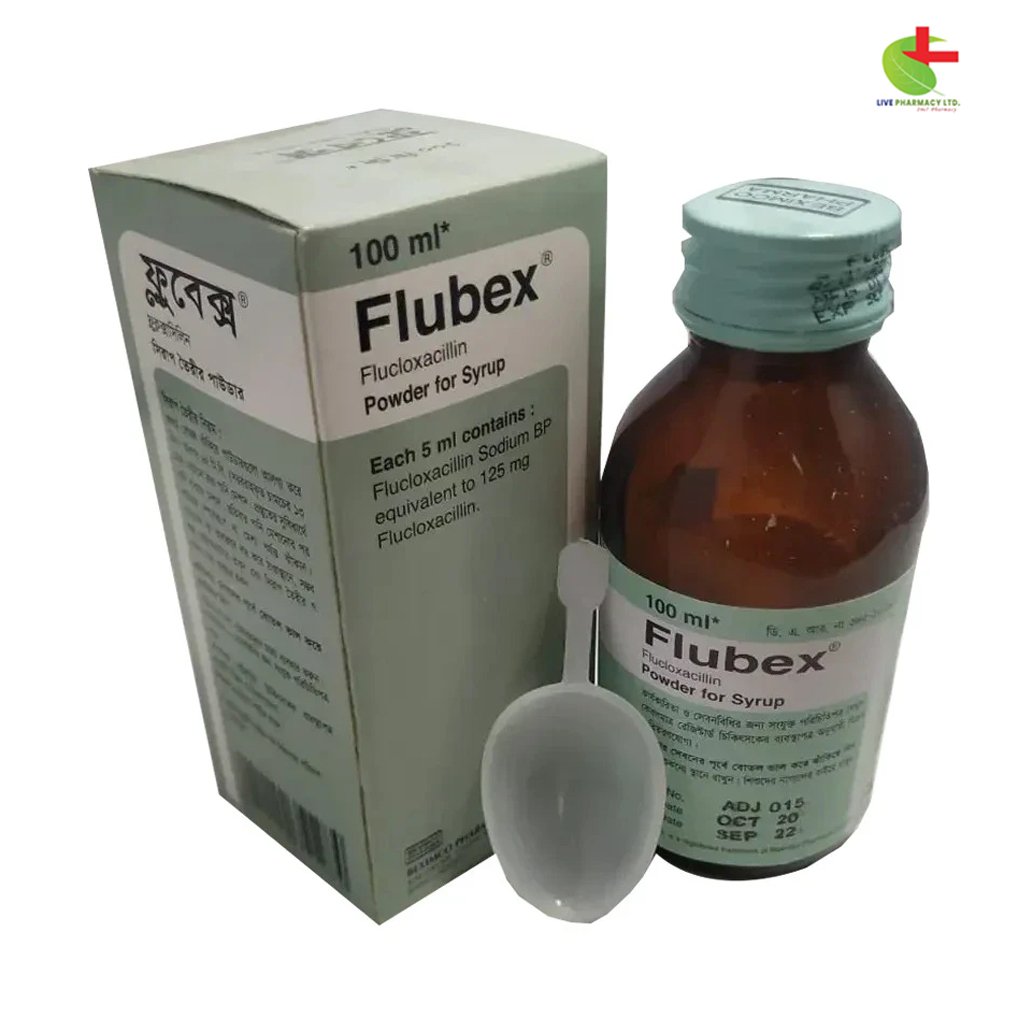Flubex
60.00৳ Bottle (100 ml)
- Flubex is a penicillinase-resistant antibiotic by Beximco Pharmaceuticals Ltd.
- Treats Gram-positive infections including skin, respiratory, and serious infections.
- Effective for conditions like osteomyelitis, endocarditis, and surgical prophylaxis.
- Available at Live Pharmacy for targeted treatment against resistant bacteria.
 Brand
Brand
|
Beximco Pharmaceuticals Ltd |
|---|---|
 Generics
Generics
|
Flucloxacillin Sodium |
Indications
Flubex is prescribed for managing a variety of infections caused by Gram-positive bacteria, including those resistant to penicillinase. This includes:
- Skin and Soft Tissue Infections: Treats boils, abscesses, carbuncles, eczema, acne, furunculosis, cellulitis, infected wounds and burns, otitis media and externa, and impetigo.
- Respiratory Tract Infections: Effective against pneumonia, lung abscesses, empyema, sinusitis, pharyngitis, tonsillitis, and quinsy.
- Other Infections: Includes osteomyelitis, enteritis, endocarditis, urinary tract infections, meningitis, and septicemia caused by susceptible organisms.
- Prophylactic Use: Used during major surgical procedures like cardiothoracic and orthopedic surgeries to prevent infection.
Pharmacology
Flucloxacillin is a potent penicillinase-resistant antibiotic effective against Gram-positive bacteria. It inhibits bacterial cell wall synthesis by targeting the transpeptidase enzyme, weakening the cell wall and leading to bacterial cell lysis. It resists penicillinase due to its acyl side chain, which protects the β-lactam ring.
Dosage
- Oral Administration:
- Adults: 250 mg four times daily; up to 8 g daily for severe infections like osteomyelitis and endocarditis.
- Children (2-10 years): Half of the adult dose.
- Children (Under 2 years): A quarter of the adult dose.
- Parenteral Administration:
- Intramuscular Injection: 250 mg four times daily.
- Intravenous Injection: 250 mg to 1 g four times daily, either by slow injection over 3-4 minutes or via infusion. For severe infections, doses may be increased up to 8 g daily.
Administration
Oral doses should be taken 1 hour before meals.
Interactions
Concurrent use of Flubex may lead to prolonged elevated levels in the bloodstream.
Contraindications
Flubex is not suitable for individuals with penicillin allergies.
Side Effects
Common side effects include gastrointestinal issues like nausea, vomiting, and diarrhea. Rare effects may include rashes, urticaria, purpura, fever, interstitial nephritis, hepatitis, and cholestatic jaundice.
Pregnancy & Lactation
Flucloxacillin is classified as FDA Pregnancy Category B. Use during pregnancy should be limited to cases where the benefits outweigh potential risks. It is excreted in breast milk; therefore, caution is advised for lactating mothers.
Precautions & Warnings
Exercise caution in patients with liver dysfunction and those with a history of allergic reactions.
Use in Special Populations
For patients with severe renal impairment (creatinine clearance <10 ml/min), dose adjustments or extended dosing intervals are recommended.
Therapeutic Class
Penicillinase-resistant penicillins
Reconstitution
Flubex can be administered by intraarticular or intrapleural injection, or nebulized. For injection, dissolve 125-250 mg in 3 ml sterile water.
Storage Conditions
Store in a dry place, away from light and heat. Keep out of reach of children.













Reviews
There are no reviews yet.